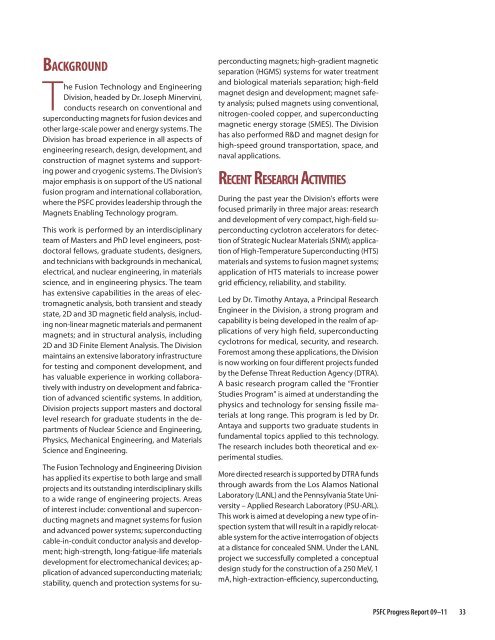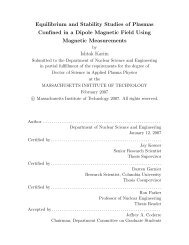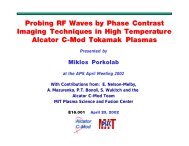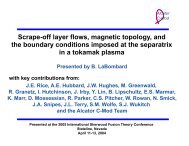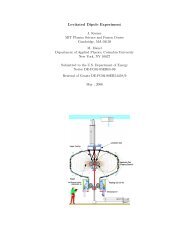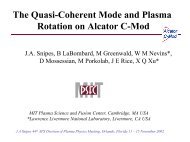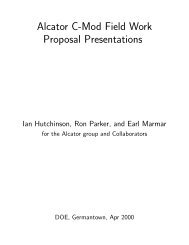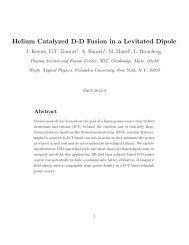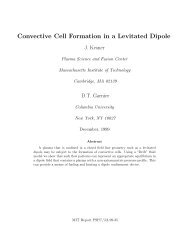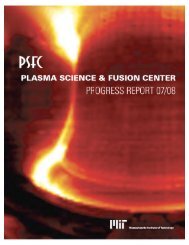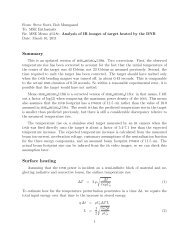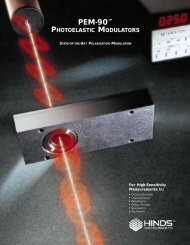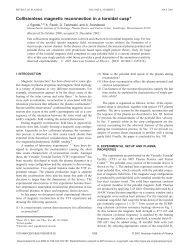Download a copy of the latest PSFC Progress Report - Plasma ...
Download a copy of the latest PSFC Progress Report - Plasma ...
Download a copy of the latest PSFC Progress Report - Plasma ...
Create successful ePaper yourself
Turn your PDF publications into a flip-book with our unique Google optimized e-Paper software.
Background<br />
The Fusion Technology and Engineering<br />
Division, headed by Dr. Joseph Minervini,<br />
conducts research on conventional and<br />
superconducting magnets for fusion devices and<br />
o<strong>the</strong>r large-scale power and energy systems. The<br />
Division has broad experience in all aspects <strong>of</strong><br />
engineering research, design, development, and<br />
construction <strong>of</strong> magnet systems and supporting<br />
power and cryogenic systems. The Division’s<br />
major emphasis is on support <strong>of</strong> <strong>the</strong> US national<br />
fusion program and international collaboration,<br />
where <strong>the</strong> <strong>PSFC</strong> provides leadership through <strong>the</strong><br />
Magnets Enabling Technology program.<br />
This work is performed by an interdisciplinary<br />
team <strong>of</strong> Masters and PhD level engineers, postdoctoral<br />
fellows, graduate students, designers,<br />
and technicians with backgrounds in mechanical,<br />
electrical, and nuclear engineering, in materials<br />
science, and in engineering physics. The team<br />
has extensive capabilities in <strong>the</strong> areas <strong>of</strong> electromagnetic<br />
analysis, both transient and steady<br />
state, 2D and 3D magnetic field analysis, including<br />
non-linear magnetic materials and permanent<br />
magnets; and in structural analysis, including<br />
2D and 3D Finite Element Analysis. The Division<br />
maintains an extensive laboratory infrastructure<br />
for testing and component development, and<br />
has valuable experience in working collaboratively<br />
with industry on development and fabrication<br />
<strong>of</strong> advanced scientific systems. In addition,<br />
Division projects support masters and doctoral<br />
level research for graduate students in <strong>the</strong> departments<br />
<strong>of</strong> Nuclear Science and Engineering,<br />
Physics, Mechanical Engineering, and Materials<br />
Science and Engineering.<br />
The Fusion Technology and Engineering Division<br />
has applied its expertise to both large and small<br />
projects and its outstanding interdisciplinary skills<br />
to a wide range <strong>of</strong> engineering projects. Areas<br />
<strong>of</strong> interest include: conventional and superconducting<br />
magnets and magnet systems for fusion<br />
and advanced power systems; superconducting<br />
cable-in-conduit conductor analysis and development;<br />
high-strength, long-fatigue-life materials<br />
development for electromechanical devices; application<br />
<strong>of</strong> advanced superconducting materials;<br />
stability, quench and protection systems for superconducting<br />
magnets; high-gradient magnetic<br />
separation (HGMS) systems for water treatment<br />
and biological materials separation; high-field<br />
magnet design and development; magnet safety<br />
analysis; pulsed magnets using conventional,<br />
nitrogen-cooled copper, and superconducting<br />
magnetic energy storage (SMES). The Division<br />
has also performed R&D and magnet design for<br />
high-speed ground transportation, space, and<br />
naval applications.<br />
Recent Research Activities<br />
During <strong>the</strong> past year <strong>the</strong> Division’s efforts were<br />
focused primarily in three major areas: research<br />
and development <strong>of</strong> very compact, high-field superconducting<br />
cyclotron accelerators for detection<br />
<strong>of</strong> Strategic Nuclear Materials (SNM); application<br />
<strong>of</strong> High-Temperature Superconducting (HTS)<br />
materials and systems to fusion magnet systems;<br />
application <strong>of</strong> HTS materials to increase power<br />
grid efficiency, reliability, and stability.<br />
Led by Dr. Timothy Antaya, a Principal Research<br />
Engineer in <strong>the</strong> Division, a strong program and<br />
capability is being developed in <strong>the</strong> realm <strong>of</strong> applications<br />
<strong>of</strong> very high field, superconducting<br />
cyclotrons for medical, security, and research.<br />
Foremost among <strong>the</strong>se applications, <strong>the</strong> Division<br />
is now working on four different projects funded<br />
by <strong>the</strong> Defense Threat Reduction Agency (DTRA).<br />
A basic research program called <strong>the</strong> “Frontier<br />
Studies Program” is aimed at understanding <strong>the</strong><br />
physics and technology for sensing fissile materials<br />
at long range. This program is led by Dr.<br />
Antaya and supports two graduate students in<br />
fundamental topics applied to this technology.<br />
The research includes both <strong>the</strong>oretical and experimental<br />
studies.<br />
More directed research is supported by DTRA funds<br />
through awards from <strong>the</strong> Los Alamos National<br />
Laboratory (LANL) and <strong>the</strong> Pennsylvania State University<br />
– Applied Research Laboratory (PSU-ARL).<br />
This work is aimed at developing a new type <strong>of</strong> inspection<br />
system that will result in a rapidly relocatable<br />
system for <strong>the</strong> active interrogation <strong>of</strong> objects<br />
at a distance for concealed SNM. Under <strong>the</strong> LANL<br />
project we successfully completed a conceptual<br />
design study for <strong>the</strong> construction <strong>of</strong> a 250 MeV, 1<br />
mA, high-extraction-efficiency, superconducting,<br />
<strong>PSFC</strong> <strong>Progress</strong> <strong>Report</strong> 09–11 33


